4.7: Optimization Problems
( \newcommand{\kernel}{\mathrm{null}\,}\)
- Set up and solve optimization problems in several applied fields.
One common application of calculus is calculating the minimum or maximum value of a function. For example, companies often want to minimize production costs or maximize revenue. In manufacturing, it is often desirable to minimize the amount of material used to package a product with a certain volume. In this section, we show how to set up these types of minimization and maximization problems and solve them by using the tools developed in this chapter.
Solving Optimization Problems over a Closed, Bounded Interval
The basic idea of the optimization problems that follow is the same. We have a particular quantity that we are interested in maximizing or minimizing. However, we also have some auxiliary condition that needs to be satisfied. For example, in Example
A rectangular garden is to be constructed using a rock wall as one side of the garden and wire fencing for the other three sides (Figure
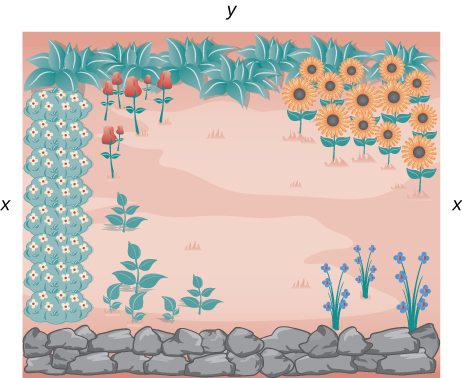
Solution
Let
We want to find the maximum possible area subject to the constraint that the total fencing is
Solving this equation for
Before trying to maximize the area function
Therefore, we consider the following problem:
Maximize
As mentioned earlier, since
Therefore, the only critical point is

Then we have
Determine the maximum area if we want to make the same rectangular garden as in Figure
- Hint
-
We need to maximize the function
- Answer
-
The maximum area is
Now let’s look at a general strategy for solving optimization problems similar to Example
- Introduce all variables. If applicable, draw a figure and label all variables.
- Determine which quantity is to be maximized or minimized, and for what range of values of the other variables (if this can be determined at this time).
- Write a formula for the quantity to be maximized or minimized in terms of the variables. This formula may involve more than one variable.
- Write any equations relating the independent variables in the formula from step
- Identify the domain of consideration for the function in step
- Locate the maximum or minimum value of the function from step
Now let’s apply this strategy to maximize the volume of an open-top box given a constraint on the amount of material to be used.
An open-top box is to be made from a
Solution
Step 1: Let
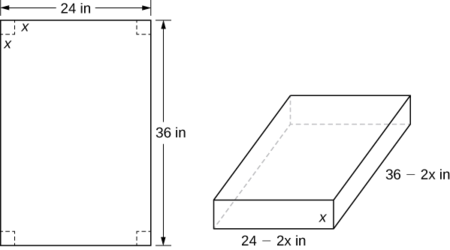
Step 2: We are trying to maximize the volume of a box. Therefore, the problem is to maximize
Step 3: As mentioned in step 2, are trying to maximize the volume of a box. The volume of a box is
where
Step 4: From Figure
Step 5: To determine the domain of consideration, let’s examine Figure
Step 6: Since
To find the critical points, we need to solve the equation
Dividing both sides of this equation by
Using the quadratic formula, we find that the critical points are
Since
as shown in the following graph.
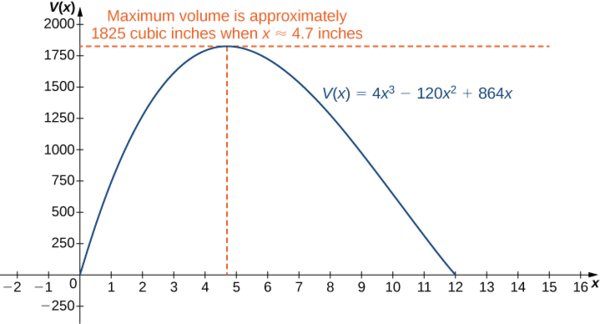
Suppose the dimensions of the cardboard in Example
- Hint
-
The volume of the box is
- Answer
-
An island is
Solution
Step 1: Let
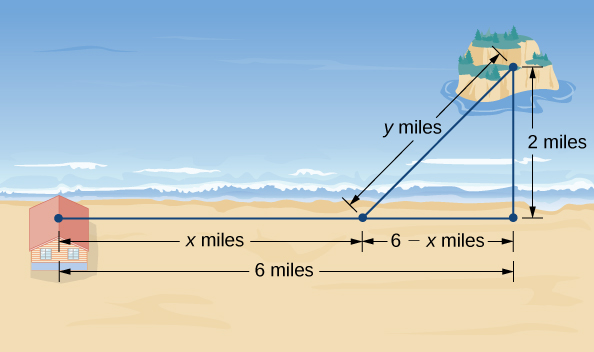
Step 2: The problem is to minimize
Step 3: To find the time spent traveling from the cabin to the island, add the time spent running and the time spent swimming. Since Distance = Rate × Time
and the time spent swimming is
Therefore, the total time spent traveling is
Step 4: From Figure
Step 5: From Figure
Step 6: Since
If
Therefore,
Squaring both sides of this equation, we see that if
which implies
We conclude that if
[Note that since we are squaring,
Therefore, the possibilities for critical points are
Since
Therefore, we conclude that
Suppose the island is
- Hint
-
The time
- Answer
-
In business, companies are interested in maximizing revenue. In the following example, we consider a scenario in which a company has collected data on how many cars it is able to lease, depending on the price it charges its customers to rent a car. Let’s use these data to determine the price the company should charge to maximize the amount of money it brings in.
Owners of a car rental company have determined that if they charge customers
Solution
Step 1: Let
Step 2: The problem is to maximize
Step 3: The revenue (per day) is equal to the number of cars rented per day times the price charged per car per day—that is,
Step 4: Since the number of cars rented per day is modeled by the linear function
Step 5: Since the owners plan to charge between
Step 6: Since
Therefore, the absolute maximum occurs at
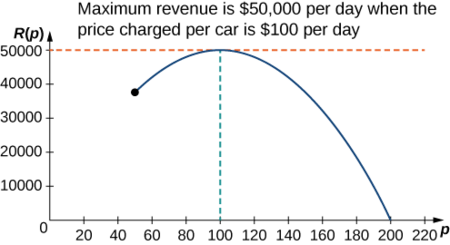
A car rental company charges its customers
- Hint
-
- Answer
-
The company should charge
A rectangle is to be inscribed in the ellipse
What should the dimensions of the rectangle be to maximize its area? What is the maximum area?
Solution
Step 1: For a rectangle to be inscribed in the ellipse, the sides of the rectangle must be parallel to the axes. Let
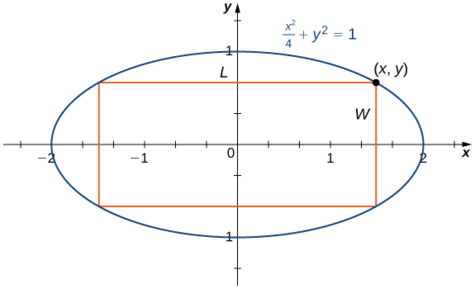
Step 2: The problem is to maximize
Step 3: The area of the rectangle is
Step 4: Let
Step 5: From Figure
Step 6: As mentioned earlier,
Therefore, the maximum must occur at a critical point. Taking the derivative of
To find critical points, we need to find where
then
Therefore,
Therefore,
Therefore, the dimensions of the rectangle are
Modify the area function
- Hint
-
If
- Answer
-
Solving Optimization Problems when the Interval Is Not Closed or Is Unbounded
In the previous examples, we considered functions on closed, bounded domains. Consequently, by the extreme value theorem, we were guaranteed that the functions had absolute extrema. Let’s now consider functions for which the domain is neither closed nor bounded.
Many functions still have at least one absolute extrema, even if the domain is not closed or the domain is unbounded. For example, the function
In the following example, we look at constructing a box of least surface area with a prescribed volume. It is not difficult to show that for a closed-top box, by symmetry, among all boxes with a specified volume, a cube will have the smallest surface area. Consequently, we consider the modified problem of determining which open-topped box with a specified volume has the smallest surface area.
A rectangular box with a square base, an open top, and a volume of
Solution
Step 1: Draw a rectangular box and introduce the variable
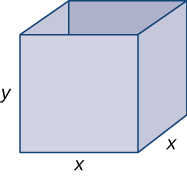
Step 2: We need to minimize the surface area. Therefore, we need to minimize
Step 3: Since the box has an open top, we need only determine the area of the four vertical sides and the base. The area of each of the four vertical sides is
Step 4: Since the volume of this box is
Solving the constraint equation for
Therefore,
Step 5: Since we are requiring that
Step 6: Note that as
Therefore,
When
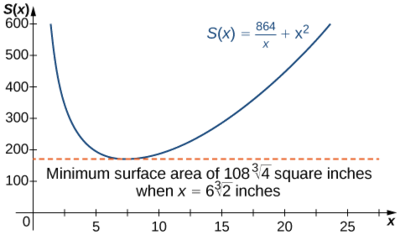
Consider the same open-top box, which is to have volume
- Hint
-
If the cost of one of the sides is
- Answer
-
Key Concepts
- To solve an optimization problem, begin by drawing a picture and introducing variables.
- Find an equation relating the variables.
- Find a function of one variable to describe the quantity that is to be minimized or maximized.
- Look for critical points to locate local extrema.
Glossary
- optimization problems
- problems that are solved by finding the maximum or minimum value of a function

